Du Fu Thatched Cottage is located at No. 37 Qinghua Road, Qingyang District, Chengdu City, Sichuan Province. It is a national 4A-level tourist attraction and one of the first batch of national first-class museums. Covering an area of nearly 300 mu (1 mu ≈ 0.0667 hectares), it completely preserves the architectural layout from the 13th year of the Hongzhi reign of the Ming Dynasty (1500) and the 16th year of the Jiaqing reign of the Qing Dynasty (1811) when it was renovated and expanded. The screen wall, main gate, Daxie (Grand Hall), Shishi Hall (Hall of Poetic History), Chaimen (Firewood Gate), and Gongbu Shrine are arranged along a central axis, with symmetrical corridors and other auxiliary buildings on both sides, forming a unique "mixed-style" classical Chinese garden.
Historical and Cultural Background
Du Fu Thatched Cottage was the former residence of Du Fu, a great poet of the Tang Dynasty, during his sojourn in Chengdu. In the winter of the 2nd year of the Qianyuan reign of Emperor Suzong of the Tang Dynasty (759), to avoid the "Anshi Rebellion", Du Fu traveled with his family from Longyou (present-day eastern Gansu) to Sichuan and eventually arrived in Chengdu. In the spring of the following year, with the help of friends, he built a thatched cottage by the Huanhuaxi River in the western suburbs of Chengdu to live in. In the spring of the 2nd year of the Shangyuan reign (761), the thatched cottage was completed and named "Chengdu Thatched Cottage". Du Fu lived here for nearly four years and created more than 240 poems.
After Du Fu left, the thatched cottage fell into disrepair and disappeared. Later, through renovations and expansions in the Song, Yuan, Ming, and Qing dynasties, it gradually evolved into a famous cultural shrine that combines the layout of a memorial temple with the style of the poet's former residence. Two large-scale renovations in the 13th year of the Hongzhi reign of the Ming Dynasty (1500) and the 16th year of the Jiaqing reign of the Qing Dynasty (1811) laid the basic layout of the existing architectural complex. In 1955, a memorial hall was established at Du Fu Thatched Cottage, and it was renamed Chengdu Du Fu Thatched Cottage Museum in 1985. Now, it is a key national cultural relic protection unit.
Major Scenic Spots
Main Gate
The two characters "草堂" (Thatched Cottage) on the horizontal plaque are engraved by rubbing from the stone tablet inscribed with "Shaoling Thatched Cottage" in the stele pavilion. The couplets on both sides, "Wanliqiao Xi Zhai, Baihuatan Bei Zhuang" (A house west of Wanli Bridge, a villa north of Baihua Pond), are from Du Fu's poem "Huai Jinshui Juzhi Er Shou" (Two Poems Recalling My Residence by the Jinshui River). This couplet indicates the geographical location of Du Fu's thatched cottage in those years: west of Wanli Bridge and north of the ancient Baihua Pond. The location of the thatched cottage at that time completely coincides with the current location of the museum.

Daxie (Grand Hall)
Daxie is an official-style building constructed by later generations to commemorate the poet, symbolizing respect for the "Poetry Sage" (a title given to Du Fu). A long couplet is hung inside the hall, and in the center stands a 2-meter-tall bronze statue of Du Fu, wearing a green robe, holding a book, and with a profound gaze. On both sides, there are displayed engraved editions and photocopies of Du Fu's poetry collections from various dynasties, as well as relevant research documents, demonstrating Du Fu's lofty status in the history of literature.
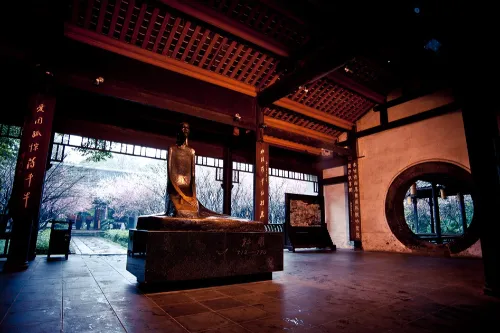

Shishi Hall (Hall of Poetic History)
Shishi Hall is the core building of the Thatched Cottage, named because Du Fu's poems are praised as "Shi Shi" (Poetic History, referring to poems that record historical events and social realities). A portrait of Du Fu hangs on the main wall inside the hall, and on both sides are couplets written by celebrities such as Zhu De and Guo Moruo. The hall displays an exhibition of Du Fu's life story, showing the poet's life trajectory from birth to death and the development of his poetry creation, serving as an important window to understand Du Fu's culture.
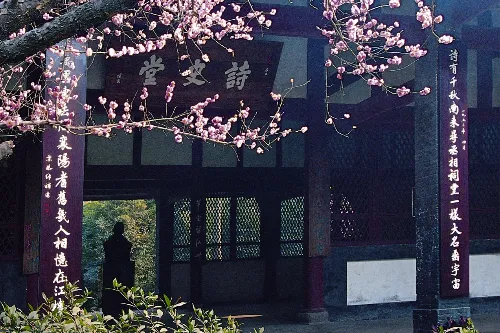
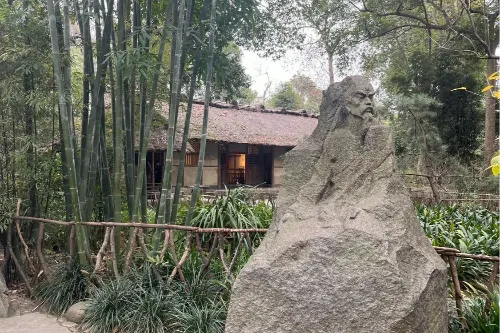
Chaimen (Firewood Gate)
The two characters "柴门" (Firewood Gate) on the plaque were written by Mr. Pan Tianshou, a master of modern Chinese traditional painting. In Du Fu's poem "Yelao" (The Old Man in the Wilderness), there is a line: "Yelao Li Bian Jiang'an Hui, Chaimen Bu Zheng Zhu Jiang Kai" (The old man by the fence watches the river bend; the firewood gate, askew, opens toward the river), in which he referred to his own courtyard gate as "Chaimen". When the Thatched Cottage was rebuilt in the 13th year of the Hongzhi reign of the Ming Dynasty, this place was called "Huanhua Shenchu" (Deep in the Huanhua Scenery). During the reconstruction in the 16th year of the Jiaqing reign of the Qing Dynasty, it was named "Yaolan Huajing" (Herb Rail and Flower Path). In the 1960s, it was renamed "Chaimen" based on the original line from Du Fu's poem "Yelao". Seven stone tablets inlaid on the walls on both sides are mostly poems written by scholars, calligraphers, or local officials of the Qing Dynasty.
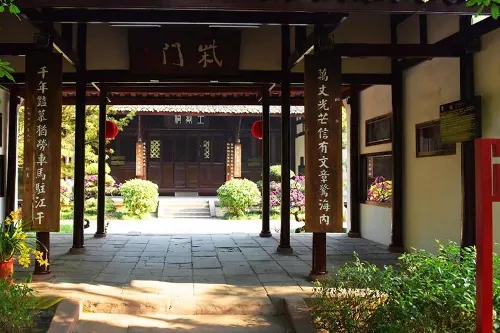
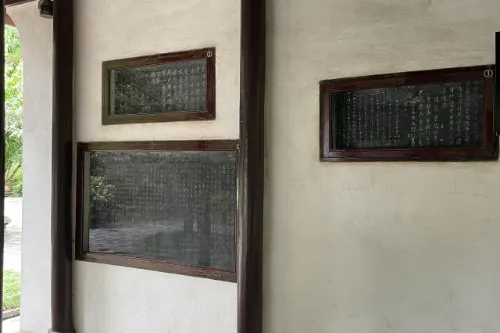
Gongbu Shrine
Gongbu Shrine is a memorial building of the Thatched Cottage, named because Du Fu once held the official position of Jianjiao Gongbu Yuanwailang (Assistant Secretary of the Ministry of Works). Inside the shrine, there is a statue of Du Fu, flanked by statues of Lu You and Huang Tingjian. The three are collectively known as the "Three Sages" who "lived in different eras". In front of the shrine stands the "Shaoling Thatched Cottage" stele pavilion; the inscription on the stele was written by Prince Guo Aixinjueluo Yunli during the Kangxi reign of the Qing Dynasty, and it is one of the landmark landscapes of the Thatched Cottage.
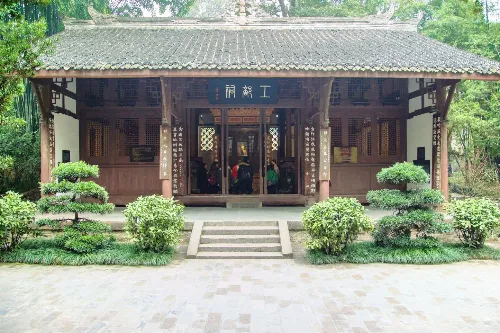
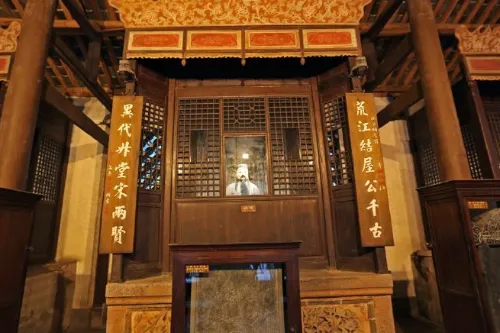
Stele Pavilion
The stone tablet in the pavilion is approximately 175 cm high and 80 cm wide. The top of the tablet is decorated with a pattern of two dragons playing with a pearl, and there are dragon patterns on the upper end and both sides of the tablet body. In the 12th year of the Yongzheng reign of the Qing Dynasty, Prince Guo Aixinjueluo Yunli was ordered to send the 7th Dalai Lama back to Tibet via Taining; when he passed through Chengdu and paid homage to the Thatched Cottage, he wrote the four characters "少陵草堂"(Shaoling Thatched Cottage). "Shaoling" was originally Du Fu's courtesy name, so later generations called him Du Shaoling, and the thatched cottage where he lived was also called Shaoling Thatched Cottage. In the 16th year of the Jiaqing reign of the Qing Dynasty, when Chang Ming, Governor of Sichuan, and Fang Ji, Provincial Administrative Commissioner, presided over the reconstruction of the Thatched Cottage, they specially built a tile-roofed house to protect the "Shaoling Thatched Cottage" stone tablet. Around the late Qing Dynasty and early Republic of China, people converted the tile-roofed house into a hexagonal thatched pavilion to symbolize the thatched cottage of Du Fu's former residence.
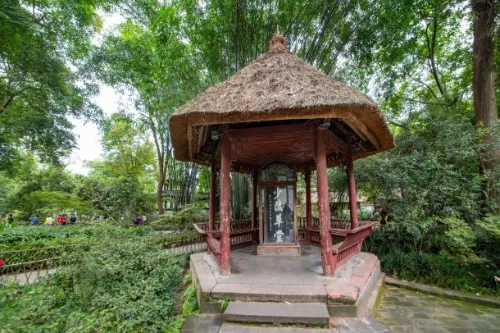
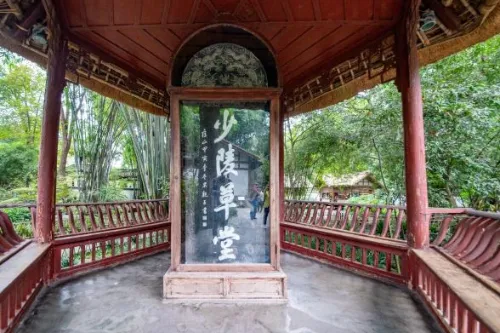
Former Thatched Cottage Residence
The Former Thatched Cottage Residence is a complex of Tang Dynasty-style residential buildings reconstructed based on Du Fu's poetic description: "Bei Guo Tang Cheng Yin Bai Mao, Yuan Jiang Lu Shu Fu Qing Jiao" (Behind the city, a hall is built, shaded by white thatch; along the river, the path is familiar, overlooking the green countryside). Covering an area of about 2 mu, it consists of a thatched house, a living room, a study, a bedroom, etc. The interior is furnished with Tang Dynasty-style furniture, restoring the living scene of Du Fu in those years. Bamboo, plum blossoms, chrysanthemums, and other plants are planted around the thatched cottage, reflecting the poet's life interest expressed in his line: "Ai Zhu Neng Yan Ke, Qiu Mei Bu Rang Chun" (Loving bamboo can entertain guests; seeking plum blossoms does not yield to spring).
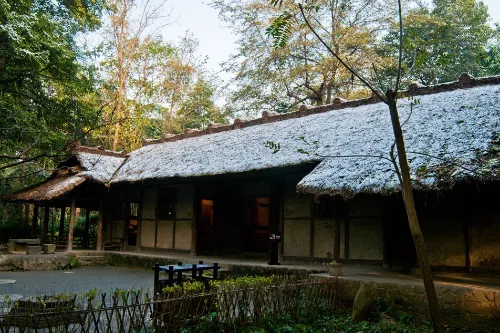
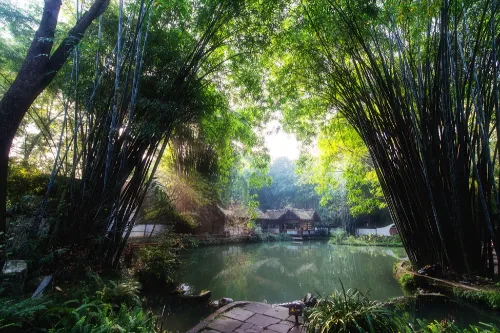
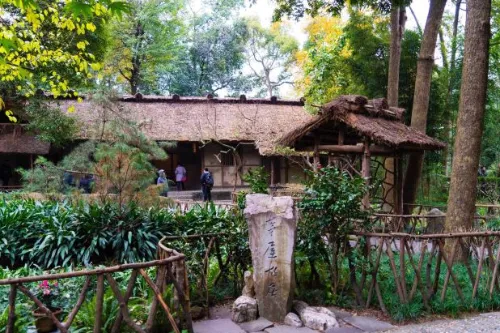
Huajing (Flower Path)
In front of Du Fu's thatched cottage, there was a path lined with flowers and trees on both sides, which was called "Huajing". Du Fu once wrote in his poem: "Huajing Buceng Yuan Ke Sao, Pengmen Jin Shi Wei Jun Kai" (The flower path has never been swept for guests; today, the thatched gate is opened for you). Today's Huajing is a red-walled path connecting the memorial temples at the former site of the Thatched Cottage and the original architectural complex of Caotang Temple. With its beautiful scenery and poetic charm, it has appeared in many promotional videos or films about Chengdu.
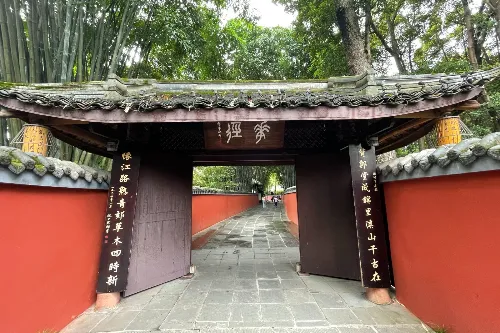
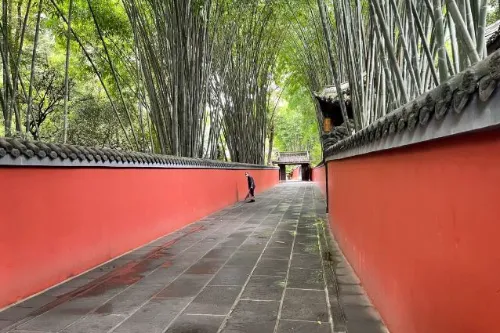
Wanfo Tower (Tower of Ten Thousand Buddhas)
Wanfo Tower was first constructed in the Tang Dynasty. Historically, it was a famous Buddhist temple in Chengdu but was later destroyed in wars. It was reconstructed in 2005, standing 21 meters tall with five floors. Featuring upturned eaves and a magnificent posture, the tower houses ten thousand Buddha statues, hence the name "Wanfo Tower" (Tower of Ten Thousand Buddhas). Climbing the tower offers a panoramic view of the Thatched Cottage, allowing visitors to experience the integrated beauty of classical garden and Buddhist culture.
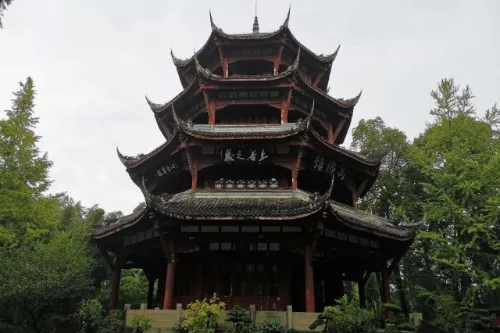
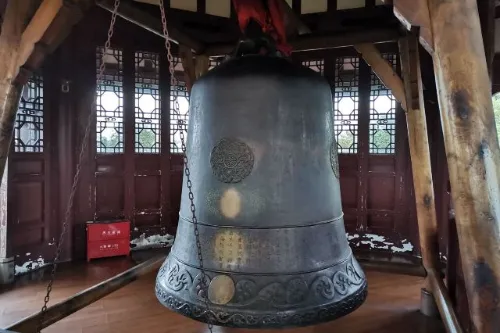
Caotang Academy
Caotang Academy was first built in the Yuan Dynasty. It was once known as one of the three famous academies in Chengdu, along with Yang Xiong's Ink Pool and Wen Weng's Stone Chamber. During the Ming and Qing dynasties, Caotang Academy underwent multiple renovations and expansions, gradually expanding in scale and once boasting the glory of "collecting 300,000 volumes of books". However, it later declined due to wars. The academy was reconstructed in 2017, covering an area of 3,586 square meters after completion.
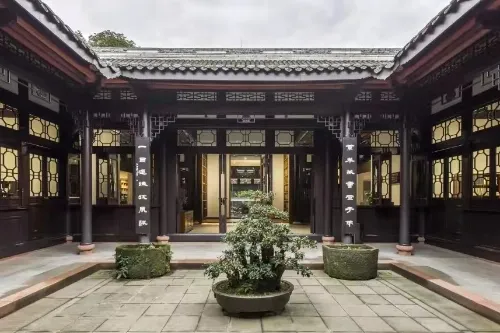
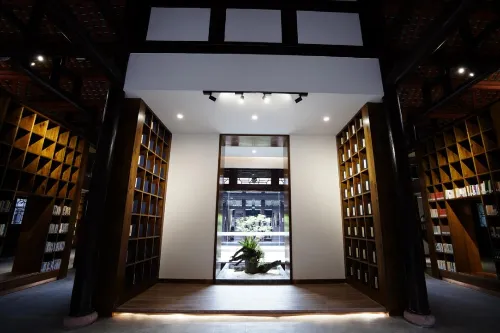
Recommended Tour Route
Recommended Tour Route: Main Gate → Daxie (Grand Hall) → Shishi Hall (Hall of Poetic History) → Chaimen (Firewood Gate) → Gongbu Shrine → Shaoling Thatched Cottage Stele Pavilion → Former Thatched Cottage Residence → Tang Dynasty Ruins Exhibition Hall → Huajing (Flower Path) → Wanfo Tower → Caotang Bookstore → Exit. This route follows the central axis, allowing visitors to visit the main buildings and scenic spots of the Thatched Cottage in sequence. The whole journey takes about 2 hours, enabling visitors to not only appreciate the architectural beauty of the classical garden but also gain an in-depth understanding of Du Fu's life and cultural achievements.
Travel Tips
- It is recommended to visit in spring (March-May) or autumn (September-November). During these periods, the climate in Chengdu is mild, and the Thatched Cottage is filled with lush flowers and trees, offering pleasant scenery.
- Reserve tickets in advance through the official WeChat public account of the scenic area to avoid queuing during holidays.
- Hire a scenic area guide (approximately 100 yuan per session) or rent an audio guide (20 yuan per unit) to gain a deeper understanding of Du Fu culture and the history of the Thatched Cottage.
- There is a teahouse in the Thatched Cottage where you can experience Chengdu's characteristic "Gaiwan Tea" (covered-bowl tea) and enjoy the leisurely life of Sichuan amidst the surrounding bamboo groves.
- There are attractions such as Sichuan Museum and Qingyang Palace nearby. You can arrange a one-day tour to experience Chengdu's culture in depth.
Notes
- Smoking and littering are prohibited in the Thatched Cottage; please keep the environment clean and tidy.
- When visiting the Former Thatched Cottage Residence, do not touch the interior furnishings to avoid damaging cultural relics.
- There are many tourists during holidays; please take good care of your personal belongings and look after the elderly and children.
- Most buildings in the Thatched Cottage are classical structures, and the ground may be slippery. It is recommended to wear non-slip shoes.
- Do not use flash when taking photos to avoid damaging cultural relics.
Transportation
- Bus: Take buses No. 1024, 165, 170, 35, 58, 82, or G74, and get off at "Du Fu Thatched Cottage Station" to reach the destination directly.
- Metro: Take Metro Line 4, get off at "Zhongyi Daxue Hospital Station", then transfer to a bus or walk about 1.5 kilometers to arrive.
- Self-driving: There is a parking lot at the Thatched Cottage, located at No. 37 Qinghua Road, with a parking fee of approximately 10 yuan per hour.
Opening Hours
The scenic area is open year-round, with opening hours from 09:00 to 18:00 (admission stops at 17:00). During legal holidays and major events, the opening hours may be adjusted; please refer to the official announcement of the scenic area for details.
Tickets
The ticket price is 50 yuan per person.
You can search for the official WeChat public account of the scenic area "杜甫草堂博物馆" to obtain the latest updates or purchase tickets online.
Online Booking
Click here to jump to the Trip.com ticketing platform for ticket purchase.


